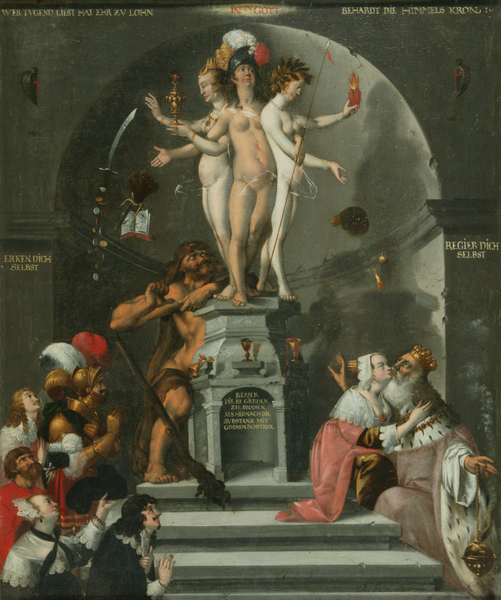Allegory of Virtue
Summary
It has not been possible to decipher the exact meaning of the many emblems in this curious painting. It can certainly be read as an allegory of virtue, since the composition is based on two classical themes: the Choice of Hercules, in which the young hero chooses to follow virtue rather than pleasure, and the Judgement of Paris, in which Paris gives the golden apple to Aphrodite, thereby spurning the other two contestants, Hera and Athena. The three female figures on the marble pedestal seem to represent Hera (left), Athena (middle) and Aphrodite (right); in this setting, however, it appears to be Athena (Wisdom) who triumphs. At the base of the pedestal kneels Hercules, recalling the theme of the choice of Virtue over Vice, while the regal figure on the right - apparently being embraced by a courtesan and accompanied by grasping courtiers - suggests that the painting could refer to good and bad government. The inscriptions read 'Who loves virtue has honour as reward' (top left); 'Earn the Heavenly Crown' (top right); 'Know thyself' (centre left); 'Control thyself' (centre right) and 'Better to subdue the desires than to suffer afterwards' (on pedestal). Very little is known of the life of Freyse, except that he came from Großbehringen (Thüringen) to Wolfenbüttel in 1643, where he was in the service of August the Younger, Duke of Braunschweig-Wolfenbüttel (1635-1666) as court painter until his death in 1652. The subject matter would have been entirely appropriate for Freyse's position as court painter.
Object Name
Allegory of Virtue
Creators Name
Date Created
1640
Dimensions
Panel: 53.1cm x 44.6cm
framed: 66cm x 56.5cm
accession number
1953.113
Place of creation
Germany
Support
Panel
Medium
oil paint on panel
Credit
Presented by Dr. and Mrs. Langley.
Legal
© Manchester Art Gallery

